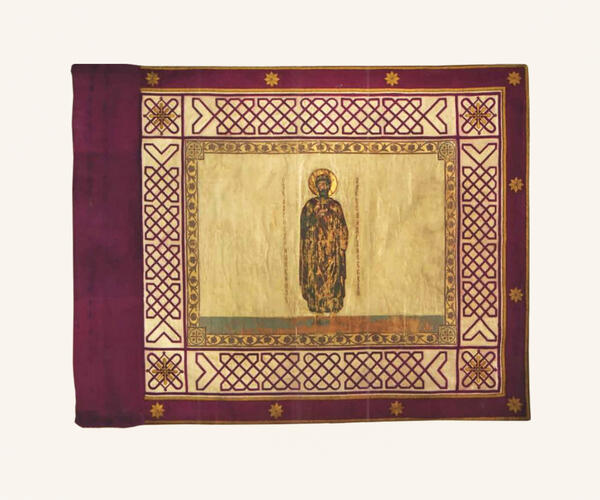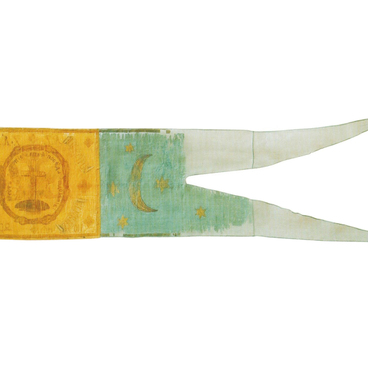In 1887, Emperor Nicholas II granted a group of simple banners to four Plastun battalions and the First Black Sea Regiment of the Kuban Cossack Troops. These banners were made of silk and followed the design of the simple banners of 1883. In the middle of each banner was an icon of Alexander Nevsky. The saint is depicted in full-length against a gray-blue background; to the left and right of his figure are the inscriptions that are stylized under the Old Slavonic font and read ‘the Saint Prince Alexander Nevsky’. The central part of the banner is framed by a plant pattern.
The reverse side of the banner is decorated with an intertwined frame. In the corners are double-headed eagles — the emblems of the Russian Empire. Their beaks, claws, scepters, orbs, and crowns are embroidered with yellow silk threads. On the chest of each eagle, an unknown master depicted the chain of the Order of St. Andrew the Apostle and the coat of arms of the Grand Duchy of Moscow — St. George slaying the dragon with his spear. The artisan used embroidery and applique techniques.
On both sides, the banner is framed by 10 eight-pointed stars, which are embroidered in yellow silk. The same stars can be found on the reverse side in the middle of the banner. Probably they refer to the Star of the Order of St. Andrew. The motto of the Order coincided with the motto of the Kuban Cossack Host and read as ‘For Faith and Fidelity’. Between these central images, the traces of a needle form the monogram of Nicholas II, which has not survived to this day. In 1917, the monogram was removed according to the order of the Provisional Government.
After the Bolshevik revolution, the Cossack regalia and relics were transported from Kuban to the United States. They were stored for almost a hundred years in the Kuban Host museum in the city of Howell, New Jersey. Only in 2007, the banner with the image of Alexander Nevsky was returned to Russia with the assistance of the Consulate-General of Russia in New York City. The relic was first sent to Moscow, where it was restored at the the State Research Institute of Restoration. On April 4, 2012, the banner was included in the collection of the Krasnodar State Historical and Archaeological Museum named E.D. Felitsyn.
The reverse side of the banner is decorated with an intertwined frame. In the corners are double-headed eagles — the emblems of the Russian Empire. Their beaks, claws, scepters, orbs, and crowns are embroidered with yellow silk threads. On the chest of each eagle, an unknown master depicted the chain of the Order of St. Andrew the Apostle and the coat of arms of the Grand Duchy of Moscow — St. George slaying the dragon with his spear. The artisan used embroidery and applique techniques.
On both sides, the banner is framed by 10 eight-pointed stars, which are embroidered in yellow silk. The same stars can be found on the reverse side in the middle of the banner. Probably they refer to the Star of the Order of St. Andrew. The motto of the Order coincided with the motto of the Kuban Cossack Host and read as ‘For Faith and Fidelity’. Between these central images, the traces of a needle form the monogram of Nicholas II, which has not survived to this day. In 1917, the monogram was removed according to the order of the Provisional Government.
After the Bolshevik revolution, the Cossack regalia and relics were transported from Kuban to the United States. They were stored for almost a hundred years in the Kuban Host museum in the city of Howell, New Jersey. Only in 2007, the banner with the image of Alexander Nevsky was returned to Russia with the assistance of the Consulate-General of Russia in New York City. The relic was first sent to Moscow, where it was restored at the the State Research Institute of Restoration. On April 4, 2012, the banner was included in the collection of the Krasnodar State Historical and Archaeological Museum named E.D. Felitsyn.



